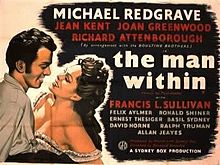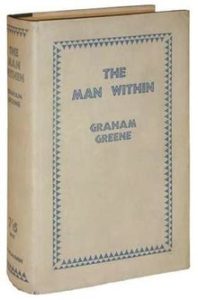The Man Within [The Smugglers] ** (1947, Michael Redgrave, Jean Kent, Joan Greenwood, Richard Attenborough) – Classic Movie Review 9121
Director Bernard Knowles’s 1947 adventure The Man Within [The Smugglers] is based on the novel by Graham Greene, and stars Michael Redgrave, Jean Kent, Joan Greenwood and Richard Attenborough.Little orphan Francis Andrews (Attenborough) solves the puzzle lurking around his strange, stern disciplinarian guardian Richard Carlyon (Redgrave) — he’s a smuggler, indeed a 19th-century smuggler chieftain! The boy is taken to sea, becomes Seaman Andrews, betrays the smugglers, and is chased by some of the cut-throat band.
It is potentially fascinating Freudian material, and it has a near ideal cast to make it work. But Graham Greene’s fine novel is turned into an utterly unremarkable film, marred by a slow pace, unconfident, jerky direction and a cheap-looking production with obvious studio exteriors. It was all filmed at Gainsborough Studios, Shepherd’s Bush, London.
The acting, usually the key to a successful Greene adaptation, mostly disappoints too, with dodgy, often misplaced performances from a quite notable cast who usually did much better work.
Attenborough’s acting, Geoffrey Unsworth’s splendidly lurid Technicolor cinematography and the film’s breathless climax are the best of it.
It was the first Technicolor movie made at Gainsborough’s Shepherd’s Bush Studios, London.
It was released in a slightly shorter version in the US as The Smugglers.
Also in the cast are Francis L Sullivan as Braddock, Ronald Shiner as Cockney Harry, Ernest Thesiger, Felix Aylmer, Basil Sydney, David Horne, Ralph Truman, Allan Jeayes, George Merritt, Maurice Denham, Charles Rolfe, Lyn Evans, Herbert Lomas, Danny Green, Torin Thatcher, Andrew Crawford, John Olson, Cyril Chamberlain, Pete Murray, David Stringer, Torin Thatcher and Allan McClelland.
The Man Within [The Smugglers] is directed by Bernard Knowles, runs 90 minutes, is made by Gainsborough, Triton Films and Production Film Service, is released by General Film Distributors (1947) (UK) and Eagle-Lion Films (1948) (US), is written by Muriel Box and Sydney Box, is shot by Geoffrey Unsworth, is produced by Sydney Box and Muriel Box, is scored by Clifton Parker, and is designed by Andrew Mazzei.
The Man Within (1929) is Graham Greene’s first novel. He later described it as hopelessly romantic and he described the film as terrible. The title refers to Thomas Browne’s Religio Medici: ‘There’s another man within me that’s angry with me.’
It was a box office failure, losing an estimated £6,500, which does not sound a lot but the film cost only £161,800.
© Derek Winnert 2019 Classic Movie Review 9121
Check out more reviews on http://derekwinnert.com

![Jean Kent stars in The Man Within [The Smugglers] (1947).](http://www.derekwinnert.com/wp-content/uploads/2019/12/1aaaMV5BMDIzNWI1YWEtOGIxZi00NGNjLWE3MGItM2Q2MDM2MmMyYTM4XkEyXkFqcGdeQXVyNTk5NzQ5Ng@@._V1_UX182_CR00182268_AL_.jpg)


